2018-2019学牛津译林版九年级英语上册全册教案
牛津译林版英语九年级上册 Unit 3 《Teenage problems.》 教学设计5
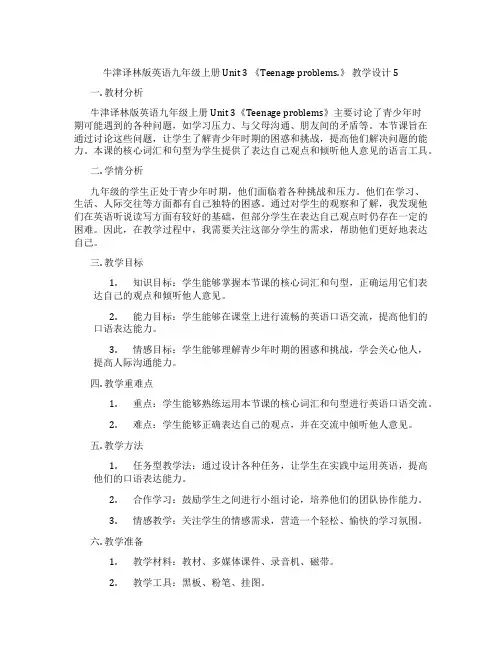
牛津译林版英语九年级上册 Unit 3 《Teenage problems.》教学设计5一. 教材分析牛津译林版英语九年级上册Unit 3《Teenage problems》主要讨论了青少年时期可能遇到的各种问题,如学习压力、与父母沟通、朋友间的矛盾等。
本节课旨在通过讨论这些问题,让学生了解青少年时期的困惑和挑战,提高他们解决问题的能力。
本课的核心词汇和句型为学生提供了表达自己观点和倾听他人意见的语言工具。
二. 学情分析九年级的学生正处于青少年时期,他们面临着各种挑战和压力。
他们在学习、生活、人际交往等方面都有自己独特的困惑。
通过对学生的观察和了解,我发现他们在英语听说读写方面有较好的基础,但部分学生在表达自己观点时仍存在一定的困难。
因此,在教学过程中,我需要关注这部分学生的需求,帮助他们更好地表达自己。
三. 教学目标1.知识目标:学生能够掌握本节课的核心词汇和句型,正确运用它们表达自己的观点和倾听他人意见。
2.能力目标:学生能够在课堂上进行流畅的英语口语交流,提高他们的口语表达能力。
3.情感目标:学生能够理解青少年时期的困惑和挑战,学会关心他人,提高人际沟通能力。
四. 教学重难点1.重点:学生能够熟练运用本节课的核心词汇和句型进行英语口语交流。
2.难点:学生能够正确表达自己的观点,并在交流中倾听他人意见。
五. 教学方法1.任务型教学法:通过设计各种任务,让学生在实践中运用英语,提高他们的口语表达能力。
2.合作学习:鼓励学生之间进行小组讨论,培养他们的团队协作能力。
3.情感教学:关注学生的情感需求,营造一个轻松、愉快的学习氛围。
六. 教学准备1.教学材料:教材、多媒体课件、录音机、磁带。
2.教学工具:黑板、粉笔、挂图。
七. 教学过程1.导入(5分钟)利用多媒体展示一些青少年时期常见的问题,如学习压力、与父母沟通等。
引导学生谈论这些问题,激发他们的兴趣。
2.呈现(10分钟)呈现本节课的核心词汇和句型,让学生通过听力练习和小组讨论来熟悉这些词汇和句型。
苏教版译林版牛津英语九年级上册9A教案(全册)
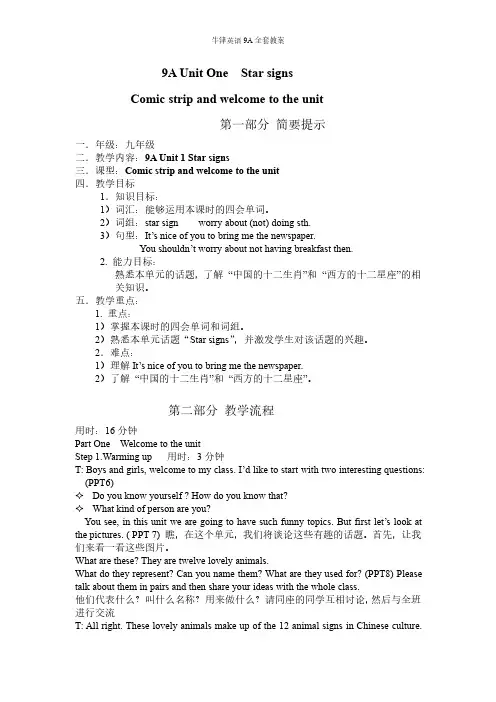
9A Unit One Star signsComic strip and welcome to the unit第一部分简要提示一.年级:九年级二.教学内容:9A Unit1Star signs三.课型:Comic strip and welcome to the unit四.教学目标1.知识目标:1)词汇:能够运用本课时的四会单词。
2)词组:star sign worry about(not)doing sth.3)句型:It’s nice of you to bring me the newspaper.You shouldn’t worry about not having breakfast then.2.能力目标:熟悉本单元的话题,了解“中国的十二生肖”和“西方的十二星座”的相关知识。
五.教学重点:1.重点:1)掌握本课时的四会单词和词组。
2)熟悉本单元话题“Star signs”,并激发学生对该话题的兴趣。
2.难点:1)理解It’s nice of you to bring me the newspaper.2)了解“中国的十二生肖”和“西方的十二星座”。
第二部分教学流程用时:16分钟Part One Welcome to the unitStep1.Warming up用时:3分钟T:Boys and girls,welcome to my class.I’d like to start with two interesting questions: (PPT6)✧Do you know yourself?How do you know that?✧What kind of person are you?You see,in this unit we are going to have such funny topics.But first let’s look at the pictures.(PPT7)瞧,在这个单元,我们将谈论这些有趣的话题。
2018年秋牛津译林版九年级英语上册Unit3集体备课教案(表格式)
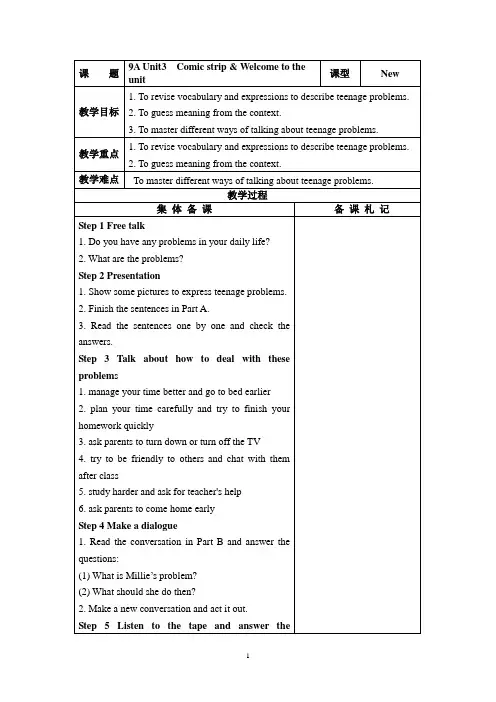
课题9A Unit3 Comic strip & Welcome to theunit课型New教学目标1. To revise vocabulary and expressions to describe teenage problems.2. To guess meaning from the context.3. To master different ways of talking about teenage problems.教学重点1. To revise vocabulary and expressions to describe teenage problems.2. To guess meaning from the context.教学难点To master different ways of talking about teenage problems.教学过程集体备课备课札记Step 1 Free talk1. Do you have any problems in your daily life?2. What are the problems?Step 2 Presentation1. Show some pictures to express teenage problems.2. Finish the sentences in Part A.3. Read the sentences one by one and check theanswers.Step 3Talk about how to deal with theseproblem s1. manage your time better and go to bed earlier2. plan your time carefully and try to finish yourhomework quickly3. ask parents to turn down or turn off the TV4. try to be friendly to others and chat with themafter class5. study harder and ask for teacher's help6. ask parents to come home earlyStep 4 Make a dialogue1. Read the conversation in Part B and answer thequestions:(1) What is Millie’s problem?(2) What should she do then?2. Make a new conversation and act it out.Step 5 Listen to the tape and answer thefollowing questions1. What problem does Eddie have? What i s Hobo’s advice?2. Why does Hobo tell Eddie not to eat too much? Step 6 Read and act it outStep 7 Fill in the blanksEddie has got a . He is getting . Hobo tells him not to too much because it is . He also tells Eddie to trymore . If Eddie does so, he willthe food for Eddie.Step 8 DiscussionWhat should (not) you do when you have some problems?Step 9 Homework1. Read the text book and learn the new words and phrases by heart.2. Recite the dialogue in Part B on page 35.3. Preview Reading.板书设计教学反思课题9A Unit 3 Reading (1) 课型New教学目标1. To guess general meanings from keywords and context.2. To skim text for overall meanings and scan for details.3. To identify specific information about Teenage problems.4. To use words to describe the Teenage problems.教学重点1. To guess general meanings from keywords and context.2. To skim text for overall meanings and scan for details.教学难点1. To identify specific information about Teenage problems.2. To use words to describe the Teenage problems.教学过程集体备课备课札记Step 1 Free talk1. What do you like to do during your free time?2. Do you like your school life in Grade 9? How do you feel? Why?3. What do you often do with your problems?Step 2 SkimmingT: … We can a lso write to newspapers and TV stations. Or sometimes we can write to youth workers like Sigmund Friend. Millie and Simon wrote two letters to him.Skim their letters and answer the two questions.1. What are Millie’s problems?2. What problems does Simon have?Finish the exercise in Part B2.Step 3 Learn some new wordsHere are some sentences in the two letters. And there are some new words in them. Can you read the new words? Read them again and try to understand the new words.Do the exercise in Part B1.Step 4 Read Millie’s letter and try to tell true or falseT: From the records we can see, Millie and Simon are feeling bad because of their problems. Do you want to help them to solve their problems? Let’s help Millie first. Listen to Millie’s letter and tel l true or false. (见课件)Step 5 Read Millie’s letter and fill in the blanket Name MillieGradeHobbiesProblems _____________ and hardly_______________________ Feeling often doubt whether_________Wish __________________ so thatshe can______________________Step 6 Have a debateT: Millie knows it’s important to do her homework. However, she hardly has any time for her hobbies. What should she focus on? Choose one and have a debate.From your debate, we can see Millie should achieve a balance between her homework and her hobbies.Step 7 Read Simon’s letter and find the sentences for the followingT: Now Read Simon’s letter loudly. Find the sentences to describe the following.Name SimonGradeHobbies Football, _______football and ___________ football.Problems Often _______________. However,hisparents____________________________Feeling Feels ___________ from time totime, because he _______Step 8 Give Simon and Millie some suggestions Finish the exercise in Part B3.Mr. Friend is rep lying to Millie’s and Simon’s letters. Help him complete the sentences with the words in the box.Step 9 Group workSimon and Millie must be happy because you give them so many suggestions. We will be happy too if we talk with others about our problem. 1. What is your problem? 2. How do you feel? 3. What are your friends’ suggestions? Work in groups and talk. Then I will ask you to come to the front to talk about your problems. Step 10 Homework1. Read aloud the article.2. Remember the new words in this lesson.板书设计教学反思课题9A Unit 3 Reading 2 课型New教学目标1. To review the details in the article.2. To learn the key phrases and drills in the article.3. To understand how to write about problems and to express feelings.教学重点To learn how to talk about problems and express feelings.教学难点To learn the key phrases and drills in the article.教学过程集体备课备课札记Step 1 Make a revision1. Ask students to read the two letters together.2. Answer some questions to remind them of the twoletters:① What is Millie’s problem?② What does she want Sigmund Friend to do?③ What is Simon’s probl em?④ What does he think of his parents?Step 2 PracticeShow two pictures of Millie and Simon, with words besidethem. Ask students to retell the two letters according tothem.Mille: lots of hobbies, a lot of homework, feel bad, focuson/ give up, achieve a balanceSimon: be crazy about, stay out late, parents stressed/angry, spend some time on hobbiesStep 3 Language points1.I don’t know how to deal with it.我不知道怎样处理它。
牛津译林版九年级上册Unit 3《Teenage problems》(Study skills)教学
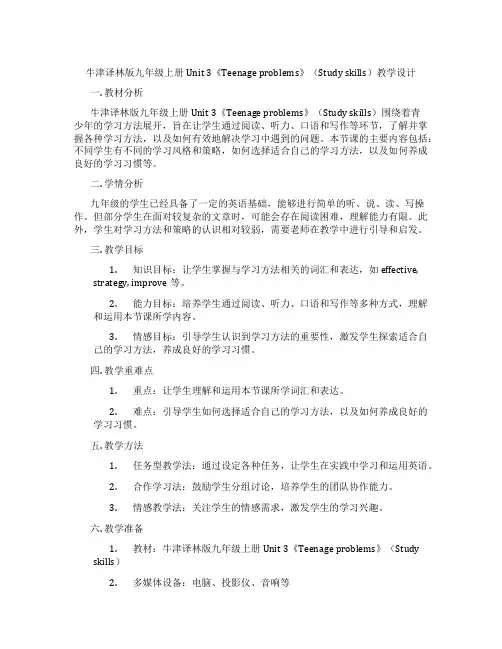
牛津译林版九年级上册Unit 3《Teenage problems》(Study skills)教学设计一. 教材分析牛津译林版九年级上册Unit 3《Teenage problems》(Study skills)围绕着青少年的学习方法展开,旨在让学生通过阅读、听力、口语和写作等环节,了解并掌握各种学习方法,以及如何有效地解决学习中遇到的问题。
本节课的主要内容包括:不同学生有不同的学习风格和策略,如何选择适合自己的学习方法,以及如何养成良好的学习习惯等。
二. 学情分析九年级的学生已经具备了一定的英语基础,能够进行简单的听、说、读、写操作。
但部分学生在面对较复杂的文章时,可能会存在阅读困难,理解能力有限。
此外,学生对学习方法和策略的认识相对较弱,需要老师在教学中进行引导和启发。
三. 教学目标1.知识目标:让学生掌握与学习方法相关的词汇和表达,如effective,strategy, improve等。
2.能力目标:培养学生通过阅读、听力、口语和写作等多种方式,理解和运用本节课所学内容。
3.情感目标:引导学生认识到学习方法的重要性,激发学生探索适合自己的学习方法,养成良好的学习习惯。
四. 教学重难点1.重点:让学生理解和运用本节课所学词汇和表达。
2.难点:引导学生如何选择适合自己的学习方法,以及如何养成良好的学习习惯。
五. 教学方法1.任务型教学法:通过设定各种任务,让学生在实践中学习和运用英语。
2.合作学习法:鼓励学生分组讨论,培养学生的团队协作能力。
3.情感教学法:关注学生的情感需求,激发学生的学习兴趣。
六. 教学准备1.教材:牛津译林版九年级上册Unit 3《Teenage problems》(Studyskills)2.多媒体设备:电脑、投影仪、音响等3.教学素材:相关学习方法的文章、视频等4.课件:制作与本节课相关的内容,包括词汇、图片、视频等七. 教学过程1.导入(5分钟)利用课件展示一些关于学习方法的名言,如“活到老,学到老”、“适合自己的才是最好的”等,引导学生思考如何选择适合自己的学习方法。
2018-2019学年最新牛津译林版(7A)英语全册教案
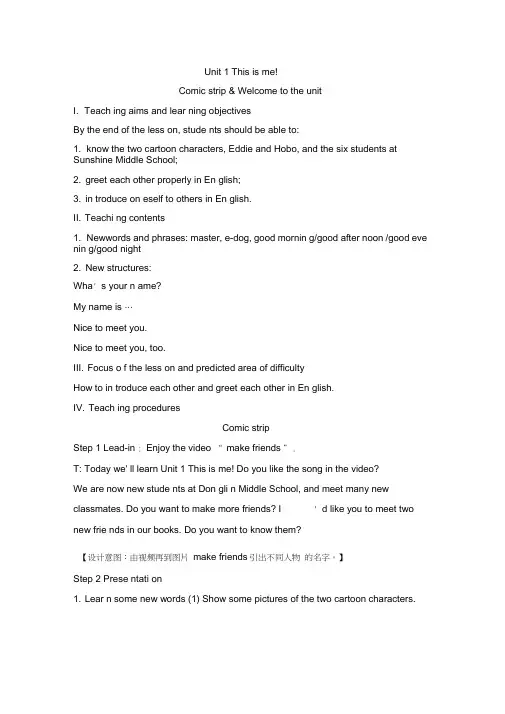
Unit 1 This is me!Comic strip & Welcome to the unitI. Teach ing aims and lear ning objectivesBy the end of the less on, stude nts should be able to:1. know the two cartoon characters, Eddie and Hobo, and the six students at Sunshine Middle School;2. greet each other properly in En glish;3. in troduce on eself to others in En glish.II. Teachi ng contents1. Newwords and phrases: master, e-dog, good mornin g/good after noon /good eve nin g/good night2. New structures:Wha' s your n ame?My name is …Nice to meet you.Nice to meet you, too.III. Focus o f the less on and predicted area of difficultyHow to in troduce each other and greet each other in En glish.IV. Teach ing proceduresComic stripStep 1 Lead-in : Enjoy the video “ make friends ”.T: Today we' ll learn Unit 1 This is me! Do you like the song in the video?We are now new stude nts at Don gli n Middle School, and meet many new classmates. Do you want to make more friends? I ' d like you to meet two new frie nds in our books. Do you want to know them?【设计意图:由视频再到图片make friends引出不同人物的名字。
牛津译林版英语九年级上册Unit3教案教学设计
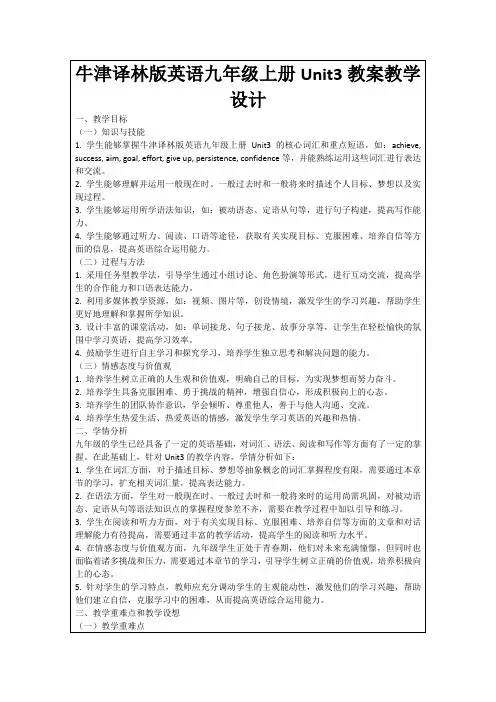
3.课堂活动:设计多样化的课堂活动,如小组讨论、角色扮演、故事分享等,让学生在实际语境中运用所学知识。
4.课后作业:布置分层作业,包括词汇、语法、阅读和写作等方面的练习,帮助学生巩固所学知识。
5.课堂小结:对本节课的学习内容进行总结,强调重点和难点,提醒学生注意学习方法和策略。
4.培养学生热爱生活、热爱英语的情感,激发学生学习英语的兴趣和热情。
二、学情分析
九年级的学生已经具备了一定的英语基础,对词汇、语法、阅读和写作等方面有了一定的掌握。在此基础上,针对Unit3的教学内容,学情分析如下:
1.学生在词汇方面,对于描述目标、梦想等抽象概念的词汇掌握程度有限,需要通过本章节的学习,扩充相关词汇量,提高表达能力。
4.教师要关注学生的作业完成情况,及时给予反馈和指导,提高学习效果。
2.语法:一般现在时、一般过去时和一般将来时的运用,以及被动语态、定语从句的掌握是语法教学的难点。学生需要通过具体实例和练习,理解并掌握这些语法知识点的用法。
3.阅读理解:如何引导学生从文章中提取关键信息,理解作者的观点和态度,以及如何将阅读策略应用到实际阅读中,是阅读教学的难点。
4.情感态度:培养学生积极向上的心态,树立正确的价值观,是情感态度教育的难点。
6.情感教育:在课堂教学中,适时穿插情感教育,引导学生树立正确的价值观,培养积极向上的心态。
四、教学内容与过程
(一)导入新课
1.教学活动:展示一组成功人士的照片和事迹,邀请学生分享他们对这些成功人士的了解和看法。
2.设计意图:激发学生对成功和目标的兴趣,为新课的学习营造积极氛围。
3.教师引导:通过提问方式引导学生思考成功的秘诀、设定目标的重要性以及实现目标所需付出的努力。
初中英语九年级上册(牛津译林版)Unit3Reading教学设计
一、教学目标
(一)知识与技能
在本章节的教学中,学生将通过阅读牛津译林版初中英语九年级上册Unit 3的Reading部分,掌握以下知识与技能:
1.掌握本节课的核心词汇和短语,如“goal, dream, achieve, effort, give up, encourage, confident”等,并能熟练运用这些词汇进行口语表达和书面写作。
3.阅读理解方面:学生在阅读过程中,能够捕捉到文章的基本信息,但分析文章结构和理解作者观点的能力有待提高。
4.情感态度方面:九年级的学生正处于青春期,他们对未来充满憧憬,但面对挫折和困难时,部分学生可能表现出信心不足、容易放弃。
5.合作意识方面:学生在小组活动中,合作意识和团队精神逐渐增强,但在具体实践中,部分学生仍需提高沟通能力和协作能力。
五、作业布置
为了巩固本节课所学知识,培养学生的语言运用能力,特布置以下作业:
1.词汇练习:根据本节课所学的核心词汇和短语,完成课后练习册中的词汇填空和翻译练习,要求学生准确无误地掌握词汇用法。
2.阅读理解:阅读一篇关于追求梦想的短文,并回答相关问题,旨在提高学生的阅读理解能力,同时让学生从他人的故事中汲取力量。
九年级的学生已具备一定的英语基础,对词汇、语法、阅读等方面有了一定的掌握。在此基础上,他们对文章的理解能力和语言表达能力有待提高。在本章节的学习中,学生可能面临以下情况:
1.词汇方面:学生对部分核心词汇和短语的理解程度不同,部分学生可能对某些词汇的用法掌握不够熟练。
2.语法方面:学生对时态的运用较为熟悉,但在具体情境中,部分学生可能对时态的选择和运用仍存在困难。
3.写作任务:以“我的梦想”为主题,写一篇不少于80词的短文,要求运用本节课所学的时态和词汇,表达自己的梦想和为实现梦想所付出的努力。
2018-2019学牛津译林版九年级英语第一学期全册教案
课题9A Unit 1 Know yourself 课型New教学目标ing some adjectives to describe one’s personalities2.To know some useful phrases in this period3.Different personalities like different jobs教学重点The usage of adjectives教学难点Grasp some adjectives and useful phrases教学过程教师内容备课札记Step 1 Self—introductionAsk some students to introduce themselves to others inclass , and T writes adjectives such as “tall .hard-working ,good” on the Bb . then tells ss they are adjectives . Givesome examples . The boy is hard-working means He is ahard-working boy .Step 2 BrainstormAsk ss to write adjectives to describe personalities asmany as possible in groups .Ask some volunteers to try toread and explain them in English . Match these adjectiveswith their meaningsOrganized-----keep….in good ordersmodest-----the opposite of show offPatient -------- without getting angrycreative ----think of new ideasCurious ------- eager to know or learnenergetic -----full of energyAsk ss to choose one adjective to describe themselvesStep 3 PracticeSB P7 Ask ss to fill in the blanks then give English for thesesentences1 你能想出好主意吗?Can younew ideas ?2 她英语学的好但从不炫耀。
牛津译林版九年级上册教案:Unit 3 Teenage problems Study skills
第三单元第 6 课时教学设计课题名称Unit 3 Teenage problemsStudy skills 复备人具体内容(包括教学内容、教学过程、板书设计、课堂练习设计等)二次备课Teaching procedures:Step 1 RevisionTranslate the following phrases:在考试中获得高分嘲笑称呼某人“书呆子”当感到悲伤时对……不予理睬以……为自豪使他感觉难过似乎比以前快乐多了Step 2 Presentation(1) T: To predict is to guess what comes next. It helps us understand what kindsof books or articles we are reading, and where we might find information.T: We can often predict the content from the title. We can also use the headingsin an article to predict the main idea of each part.(2) Ask Ss to complete Part A on page 45. Then talk ahout the reasons.(3) T: To get a general idea of a book or an article, we should ask some basicquestions. If we perdict the answers that the questions might have, it will helpus find the answers more quickly and easily when we read in details.(4) Ask Ss to complete Part B on page 45. Check the answers with the wholeclass.Step 3 PractiseComplete the exercises in “课课练”.Step 4 Homework(1) Complete the exercises in the Wb.(2) Preview “Task”.教后反思(红字)。
牛津译林英语九级上教案
布 置作 业
1.完成《课课练》
3.预习Reading中的新单词。
板 书
设 计
9A Unit8
Welcome to the unit
go missing make notes on sb
tell the truth…..of medium height
教 学反 思
年 级
Grade 9
年 级
Grade 9
学 科
English
课时
第一课时
课 题
9AUnit8Welcome to this unit
教 学
目 标
1. 了解罪行的线索。
2. 阅读关于四个犯罪嫌疑人的笔录。
3. 学会谈论谁有可能是凶手。
4. 培养学生的推理能力。
重 点
难 点
词汇:missing untidy truth guess lie
Teachers: Sherlock Holmes is a famous detective created by Arthur Conan Doyle.
He is very clever and has a wide knowledge of different things. Hve you read any books about him
二、自主合作---探锚
探究活动一:Presentation
Teacher: Where was the victim killed The Class 1, Grade 9 students are reading about the murder in the newspaper. Now let’s listen to the newspaper article to find out more about the murder.
